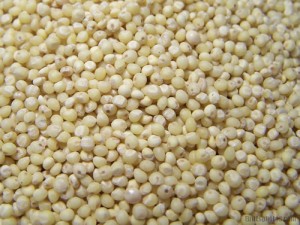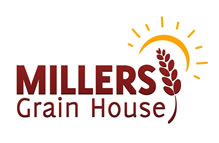 Low gluten and gluten-free items can be very expensive to buy in the store. So if you want to know what you’re getting and if it ‘s right for your gluten-free or lower gluten diet, it would be good to learn a little more about the grains you can use. I began my journey in home-milling because of a diagnosis of gluten sensitivity. Thankfully I found it was the processing of wheat flour that was my issue, not the gluten (as is the case in many people’s mis-diagnosis) and I can again eat freshly milled whole wheat. But I did learn of several grains that work well for a lower gluten or gluten-free diet.
Low gluten and gluten-free items can be very expensive to buy in the store. So if you want to know what you’re getting and if it ‘s right for your gluten-free or lower gluten diet, it would be good to learn a little more about the grains you can use. I began my journey in home-milling because of a diagnosis of gluten sensitivity. Thankfully I found it was the processing of wheat flour that was my issue, not the gluten (as is the case in many people’s mis-diagnosis) and I can again eat freshly milled whole wheat. But I did learn of several grains that work well for a lower gluten or gluten-free diet.
Because these grains all contain a trace to no gluten, they will all require some kind of binding agent in the recipe in which you use them. Gluten protein forms strands to hold dough together when baking. These grains do not have those strands so you cannot replace the milled flour of a low to no gluten grain exactly for wheat flour.
Millet (pictured above) is one of the staples in a gluten free diet. Millet can be cooked as a replacement for couscous (which is a wheat pasta, not a grain) or milled into a flour.
Quinoa is another low gluten grain. It is very high in protein and also cooks well whole.
Rice is a gluten-free grain. When milled the flour is very fine and suitable for thickening sauces.
Rye is an extremely low gluten grain. The flour is suitable for baking flat breads and using in batter bread mixtures.
Corn is low gluten. There is a trace amount of gluten & starch in some corn meals.
Oats can contain a trace amount of gluten. If you suffer from Candida or Celiac’s , be sure the oats you purchase are labeled ‘Gluten-Free’ since not all oats are gluten free.
Spelt is another grain often used in low to no gluten diets, but it does indeed have trace amounts of gluten in it. It can be kneaded but only for a short time after which over kneading causes the dough to become very sticky.
Kamut is not low or gluten-free. Kamut is an ancient grain akin to today’s wheat derivative.
Let me encourage you that if you have been diagnosed with a gluten sensitivity or a gluten intolerance, you may be able to enjoy whole wheat bread again if you mill the wheat at home and use it fresh. However, if you have been diagnosed with Candida or Celiac’s consider milling these low to no gluten grains at home to save yourself some money and give you variety in your diet.
9 Responses to Lower Gluten & Gluten-Free Grains.
Leave a Reply



Could you explain to me more about the gluten-sensitivity and how Freshly Milled Whole Wheat can help? My son gets a rash when he eats anything w/ wheat and we have changed him to a gluten free diet which has cleared him from the rash. We are learning and moving toward milling our own grain…but when someone else mentioned their child did well w/ whole wheat (when they also had a rash from “old” flour) once they started milling, they made me wonder if my son would have the same results. So this may not be a gluten allergy but more so a reaction to the processed flour? Is that correct? If this is so, this would make Milling our own even more worth it, if I didn’t need to change our wheat and learn to make gluten free all at the same time 🙂
Melonie.
If he is not diagnosed with Celiac’s then, yes you may be able to clear up his rash/symptoms by home-milling. This is exactly what I did when I was diagnosed with a ‘gluten intolerance.’ Long story short was that it was the processing/stripping/oxidizing of ‘dead’ bagged flour that was (and still is) my issue.
The whole grain is designed to work together – not segregated as we have made it for our modern SAD (Standard American Diet).
You might like an article I wrote on the subject and a radio show I did on the subject.
Radio show – I think it’s the second one on this page: http://www.millersgrainhouse.com/radio-show/
Article – on our other blog – http://www.eatgrains.com/wheat-information/diagnosis-of-gluten-sensitivity-leads-to-home-milling/
Feel free to call us if you have any questions or need help deciding how to proceed.
Best Blessings!
Donna Miller
Hi Donna, I’m so glad to hear that it was the processing and not actually the wheat that was the culprit in your case. My best friend and her children eat gluten free and I’ve seen how frustrating and expensive it can be. I’m trying to encourage her to try freshly milled wheat (I bought a Nutrimill a few years back and have been baking your awesome easy whole wheat once or twice a week ever since.) In the meantime, however, or in case their problem is truly related to the gluten, I was wondering if you would be able to share one of your favorite gluten free bread recipes or refer me to a source you found helpful? Also I was wondering if there was a special way you cleaned your mill in between milling gluten and gluten-free flours? Thanks so much!
Hi Mendy!
So sorry not to reply sooner. I did not even get a notice that you’d left a comment )o:
The easiest thing for someone who really MUST stay gluten free to do is stick with flat breads, batter breads and cracker-type ‘breads’. They will be far less frustrating than trying a yeast type loaf of bread or rolls which require so many other added ingredients to replace the gluten. Many gluten free flours (millet, rice, amaranth, etc) that can be milled at home will work in flat or batter options. Recipes? Well, since not having to worry about it as much anymore – I know I HAVE some, but where there are is a mystery! I’ll try to find/include a few in Newsletters.
As for cleaning the mill from wheat to non-gluten items to be milled. Since it was not actual Celiacs Disease – I did not do any SERIOUS cleaning between grains. But if it were, I would say to mill 1 Cup of the non-gluten grain or beans and throw away (yikes, I know) that cup of flour – then clean the hopper again and mill the remaining non-gluten items. Or another option is to have one mill for gluten-free and one for wheat. I would do the later in extreme cases of Celiacs.
Thanks for your kind and encouraging words Mendy! I know your friend must appreciate your concern and attempts to help too. Let me know if I can assist in any more ways – I’d be delighted!
Best Blessings!
Donna
is the grain millers quick cooking oatmeal gluten free? thank you and have a wonderful holiday
Hi Wynn.
All Oatmeal contains a trace amount of gluten unless otherwise processed to specify it is not. This one was packaged along side wheat so there is likely a higher transmitted airborne gluten.
Hi Donna,
I am diagnosed with Hashimoto’s hypothyroid disease(autoimmune disease). Although I am not sensitive to gluten, but I do wanna cut down on its intake as it can only increase the number of antibodies in my body and make my condition worse..
I do not wish to go completely gluten free, I wish to only reduce the amount of gluten in the wheat flours. As you mentioned you make your flour at home, could you please post your procedure to making this?
You did mention a link in another comment that leads to an article of yours on “Eat Grains” website. There you mentioned that you add 4 ingredients into the flour when you mill at home. Could please enlighten us?
Thanks! You gave me so much hope by saying home milled wheat flour is absolutely fine to maintain in the diet!
Hi Sana.
Perhaps listening to this this radio show. may be of some help.
I grind all my grains at home. Gluten Free ones or wheat. The digestive issue for me had stemmed from the processing that flour goes through to make it sit on the shelf longer. Not the wheat itself in it’s whole form (all parts used). I have a video that helps to explain that a little more clearly – http://www.youtube.com/watch?v=y_GR4nLsLJs Perhaps that will help. You can even spend some time on the Youtube Channel and see how easy the process is at home
About my reference to ‘add 4 ingredients’ I’m not sure exactly what that might be. Was I talking about my home-made bread recipe? It has a total of 5 ingredients. Perhaps that was it?
I’d be happy to help as much as possible – please don’t hesitate to ask!
Best Blessings,
Donna
Einkorn is another up and coming low-gluten wheat. Can you put this on your list?